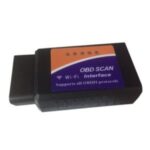Connecting an OBD2 scanner to your car’s computer should be simple. However, sometimes you might encounter the frustrating “No Communication” error. This article explores common reasons why your OBD2 scanner might not be reading and provides troubleshooting steps to get you back on track.
Most communication issues stem from a few key areas: ignition key position, voltage problems at the connector, incorrect communication protocols, a frozen Engine Control Module (ECM), missing or corrupted data, and outdated ECM software. Let’s delve deeper into each of these potential problems.
OBD2 Scanner Compatibility Issues
While most OBD2 scanners adhere to standardized protocols, some vehicles, particularly older models, may use manufacturer-specific protocols like ALDL, MOBD, MUTT, or OBD1. If your OBD2 scanner isn’t reading, ensure it’s compatible with your vehicle’s specific protocol. A professional multi-system diagnostic scanner with broader compatibility might be necessary for older or less common vehicles.
Check Your Ignition Key Position
Many OBD2 scanners require the ignition key to be in the “Run” position (engine off but accessories on) or the engine to be running. Additionally, allow sufficient time for the vehicle’s systems to fully boot up after turning the key. Try connecting the scanner only after all dashboard lights and chimes have ceased.
Verify Connector Voltage
A functioning OBD2 port needs 12 volts on pin 16 and a ground connection on pins 4 and 5. With the ignition key in the “Run” position, use a voltmeter to check for 12 volts DC between pin 16 (positive) and pin 4 or 5 (negative). A reading significantly below 11 volts can hinder connectivity. Low voltage suggests a battery or charging system problem. No voltage likely indicates a blown fuse, which should be replaced after consulting your owner’s manual.
Is Your ECM Hung Up?
Sometimes, the ECM can lock up, preventing communication despite the vehicle running normally. If other checks prove fruitless, try rebooting the ECM. Disconnect both battery cables and press the brake pedal to discharge any residual power. Reconnect the battery after a few minutes. This process often restores communication. Always consult your owner’s manual before disconnecting the battery.
Dealing with Missing or Invalid Data
OBD2 scanners query the ECM for vehicle-specific data identifiers (PIDs). If the scanner assumes the wrong vehicle, the PIDs won’t match, resulting in missing or inaccurate data. Most scanners allow you to manually initiate a PID scan, ensuring the correct data is retrieved. This process might take a minute but ensures accuracy.
Conclusion
Troubleshooting an unresponsive OBD2 scanner involves a systematic approach. By checking these common culprits, you can often pinpoint the issue and restore communication. Remember, using a diagnostic scan tool effectively requires some understanding of vehicle systems. If problems persist, consult a qualified automotive technician. Choosing a reputable supplier for your diagnostic tools ensures access to support and guidance when needed.
